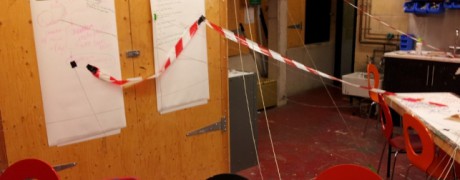Welcome to the Engine House Tool Kit – an array of instruments for your virtual artist’s utility belt as you grapple with the forces of inter-disciplinary work.
New tools will be added quarterly as part of the practical outcome from David’s Digest, so let us know what you think: and if you have tools to share please let us know via the Contact page.
Tool #2: Learn a New Language
This second tool leads on directly from Tool #1, which was an exercise for artists from separate disciplines to share their first-draft process (or equivalent) through organising the stages of their creativity into columns, and then through a visual diagram and discussion.
It exposed the shape of each artists’ creative thinking or ‘mapping’ to one another, illustrating how they refine their artistic instincts into solid choices and revealing what creative vocabulary they use along the way.
Reflecting the recent move of our three seed ideas from the abstract to the practical, this second tool is also an exercise for practical collaboration rather than discussion of methodology.
Step 1: Identfiy a Stimulus
Your artists choose a common stimulus that relates to their project – in our case it would be a site (a building, a space, an environment). It’s helpful if the stimulus is something that doesn’t directly link to any of your artist’s existing languages (so if you have a playwright and a musician, best not to choose a theatre space or a piece of music).
Step 2: Mine the Stimulus
The artists separate and ask of the stimulus / site the following questions. You might need to adapt these to be most useful to the stimulus in question, but here are the ones we recommend for sites:
Observing Abstracts (subjective):
- the emotion it seems to have, that it causes in you or potentially others
- its dynamic: fast, slow, flickering, lopsided, erratic, steady
- its atmosphere: calming, troubling, haunting
Observing the Imagined (the past):
- past voices
- past sounds
- past events and uses / misuses
Observing Wormholes (imaginative leaps)
- fantastical connections to other places
- echoes of other genres
- leaps to other events
- echoes of people inspired by the site’s resonances
Allow plenty of time to complete this stage – around an hour to really investigate and dream.
Step 3: Graphic Documentation
The artists now work together, using the information they’ve mined from Step 2, to create a graphic documentation of the stimulus / site on a large sheet of paper. This is a pictoral or diagrammatic expression of its dynamics, shape, atmosphere, mood, character and hidden stories.
As far as possible this graphic documentation should avoid symbols, shapes or visual vocabulary that is common to the artists already (so to continue with the example above, perhaps no story arc shapes for the playwright, and no staves or notes for the musician).
For an example of what this could look like, have a look at the example in David’s Digest #2.
Try and complete this step of the exercise without verbal discussion – the two artists simply responding to one another’s offers on the sheet, quietly building a graphic map of how the site collectively feels to them.
Step 4: Constructing a Language
Once the graphic documentation is complete, the artists step back and consider it as a composite score for interpretation.
What does it mean to a writer, a dancer, a musician, an audio-visual artist, a sculptor, a composer, a puppeteer to ‘play’ this composition together? Where do their ideas meet or helpfully collide?
Working together, the artists start to create a performance language which could be their interdisciplinary voice. This doesn’t mean the individual performance languages of their own disciplines doing separate things simultaneously (a writer creating words that the musician then underscores, or a piece of text replying to a piece of music and so on), but a way for them to build a new performance language that weaves the two together.
For example: the writer creates onomatopoeic text that sounds like violins swooping and falling; the musician makes his instruments speak to one another in iambic pentameter – as long as the outcome in either case is an attempt to express this new graphic documentation performatively.
Think about how your own language might need to bend, fold, recede, make way or come to meet and receive the other.
Step 5: Make A Section!
Try to create a small continuous section of performance using this new language.
Step 6: Be Prepared to Fail
This isn’t a foolproof technique for solving interdisciplinary collaboration – it’s a way in to discovering how performance languages can blend together rather than solely operate on a call-and-response basis, or as separate elements with separate jobs to do for the audience.
See what works, what doesn’t and what new rules or principles emerge that are helpful.
Tool Rule #2: Find a way of levelling the different performance languages in the room by creating an entirely new one, and avoiding the habits and safeguards that protect everyone – including your future audience – from the unknown.

Comments are closed